See The Righteious Gemstone and Boole vs. Galois.
Update of 9:48 AM EDT Oct. 28 . . .
Related material —
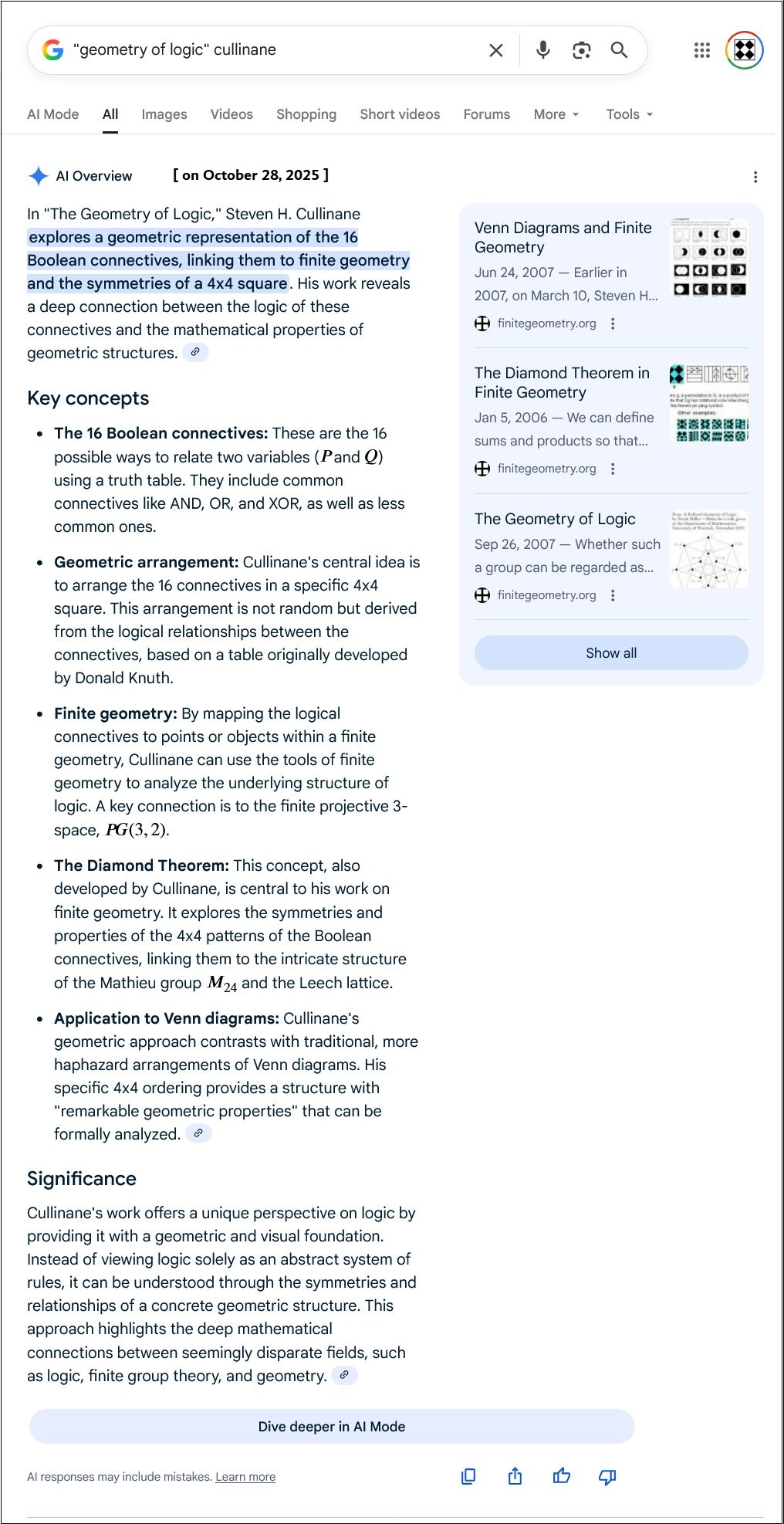
Markdown version uploaded Oct. 28, 2025, to NotebookLM.
See The Righteious Gemstone and Boole vs. Galois.
Update of 9:48 AM EDT Oct. 28 . . .
Related material —

Markdown version uploaded Oct. 28, 2025, to NotebookLM.

"Into this house we're born . . . ." — Another song lyric.
Updates, later the same day . . .
Related Art —
From the post "A Concrete Universal," August 18, 2007 —
|
“No matter how the film is done,
— Robert Redford to |

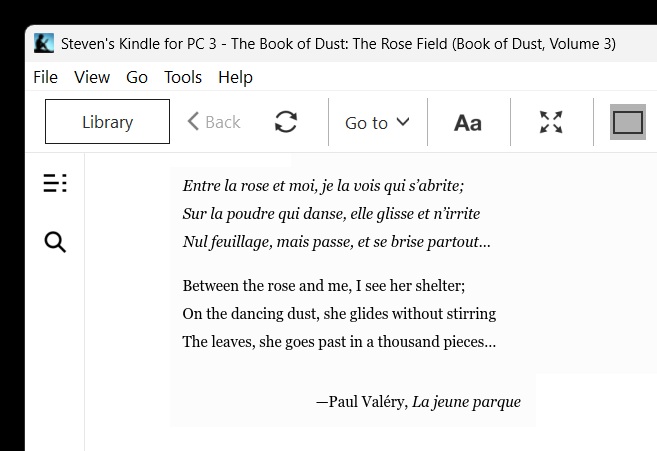
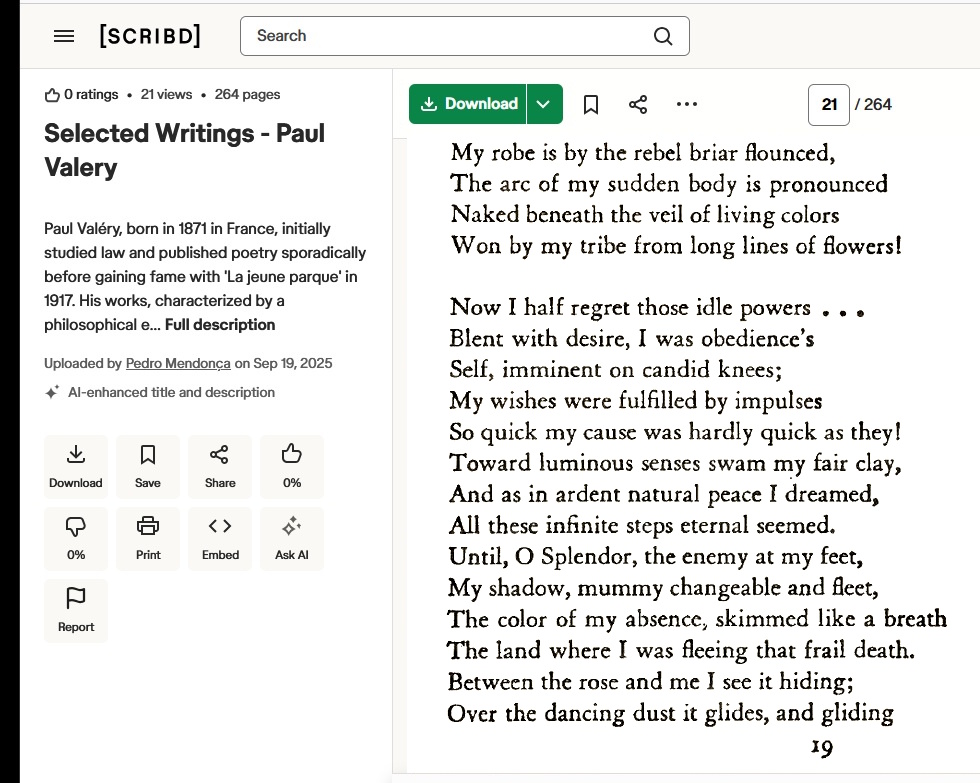
Update of about 1:30 PM EDT Thursday, October 23, 2025
|
https://muse.jhu.edu/pub/1/article/663593/pdf From La Jeune Parque by Paul Valéry Ned Balbo The Hopkins Review Johns Hopkins University Press Volume 10, Number 2, Spring 2017 pp. 168-178 In lieu of an abstract, here is a brief excerpt of the content: Paul Valéry's La Jeune Parque is widely considered one of the most important poems of the twentieth century, yet it's one that few American readers know. It's easy to see why. The poem is written in the French heroic line—rhymed alexandrines (hexameters)—held together by extraordinary attention to syntax, enjambment, and pacing. Most of the line breaks correspond to natural syntactic turns or punctuation, many are end-stopped, and well-placed caesuras abound (as we'd expect in hexameters). It is difficult to produce an English equivalent that conveys the original's elegance and fluency. Add to these factors a narrative in which nothing much happens, at least not in the usual sense: A young woman stands outside on a starry night, overlooking the ocean, contemplating her connection to time, death, and the natural world as day approaches. In Jacques Duchesne-Guellemin's summary, the Young Fate "presents herself to us with her thoughts, her memories, her questionings, all on the verge of tears; bristling, listening to her own heartbeats; blushing with shame or pale with fainting" ("Introduction to La Jeune Parque," Yale French Studies 44: 1970). Despite Valéry's success in depicting shifting emotional states through vivid metaphor and images, this is not a recipe for easy reading. Yet the poem's influence—and its author's—are undeniable. Writing in the June 1982 Critical Quarterly, Tony Pinkney observed, "Few writers commanded as much of T. S. Eliot's critical attention as did Paul Valéry.… Eliot was convinced that it was Paul Valéry 'who will remain for posterity the representative poet, the symbol of the poet, of the first half of the twentieth century—not Yeats, not Rilke, [End Page 168] not anyone else.'" Eliot's introduction to Valéry's The Art of Poetry (Bollingen edition) confirms his admiration for the poet some call "the last symbolist"—"Valéry in fact invented, and was to impose upon his age, not so much a new conception of poetry as a new conception of the poet"—and Eliot further maintains that Valéry's two greatest poems (La Jeune Parque and "Le Cimetière Marin") are "likely to last as long as the French language." Eliot is not the only world poet Valéry influenced. Tony Brinkley points out that echoes of "Le Cimetière Marin" are present in the "oceanic rhythms" of Wallace Stevens poems such as "An Ordinary Evening in New Haven," and he also reminds us that one of Rilke's last creative projects was to translate the poetry of Valéry ("Reading Valéry in English," Cerise Press 3:7, 2011). But not La Jeune Parque, which, according to Rilke, was "untranslatable … (if only someone could convince us otherwise!)." Years later, in response, Paul Celan attempted to do just that in Die junge Parze, a version that was more Celan's than Valéry's. The Young Fate has found her way into Italian and Spanish versions, too. For those seeking a look at early editions, MoMA's permanent collection includes a beautiful 1921 edition published in Paris by Revue Nouvelle Française with a lithograph by Picasso. La Jeune Parque has attracted several translators to English. The versions most widely available are those by David Paul (in Paul Valéry: An Anthology, Princeton University Press, 1976), and a version by Jackson Mathews (in Selected Writings of Paul Valéry, New Directions, 1950/1964). Both follow Valéry's pace in English texts that literally parallel the original—in part because the original's rhymed alexandrines, and the poem's length, are central to the ways that Valéry's thought unfolds. To alter the pacing would undermine the poem's intensity—the way its speaker responds to constantly changing perceptions. But the differences are instructive: Paul's version ("The Young Fate") is faithful to the author's content in unrhymed lines that fall loosely into pentameter or hexameter, while Mathews's "Fragments from 'The Youngest of the Fates'" accepts the challenge of producing [End Page 169] an English version in smoothly rhymed heroic couplets. To a…. |
Another brief summary . . .
"Naked beneath the veil of living colors . . . ."
Colors —
Beneath the veil —
"You've got to pick up every stitch . . . ." — Song lyric
|
Louis H. Kauffman on the Logic Garnet — "This is a remarkable connection of polyhedral geometry with basic logic. The meaning and application of this connection is yet to be fully appreciated. It is a significant linkage of domains. On the one hand, we have logic embedded in everyday speech. One does not expect to find direct connections of the structure of logical speech with the symmetries of Euclidean Geometry. It is the surprise of this connection that appeals to the intuition. Logic and reasoning are properties of language/mind in action. Geometry and symmetry are part of the mindset that would discover eternal forms and grasp the world as a whole. To find, by going to the source of logic, that we build simultaneously a world of reason and a world of geometry incites a vision of the full combination of the temporal and the eternal, a unification of action and contemplation. The relationship of logic and geometry demands a deep investigation. This investigation is in its infancy."
— Louis H. Kauffman, "The Mathematics of Charles Sanders Peirce." |
Wikpedia on the Logic Garnet —
Zellweger himself reportedly died on August 7, 2022.
From "The Hemingway Clause" (May 4, 2023) —
Sorkin in Paris: Walk and Talk

See also http://m759.net/wordpress/?s=Walk+Talk.
See also this journal on the above YouTube date.
A word from Sunday's scholium —

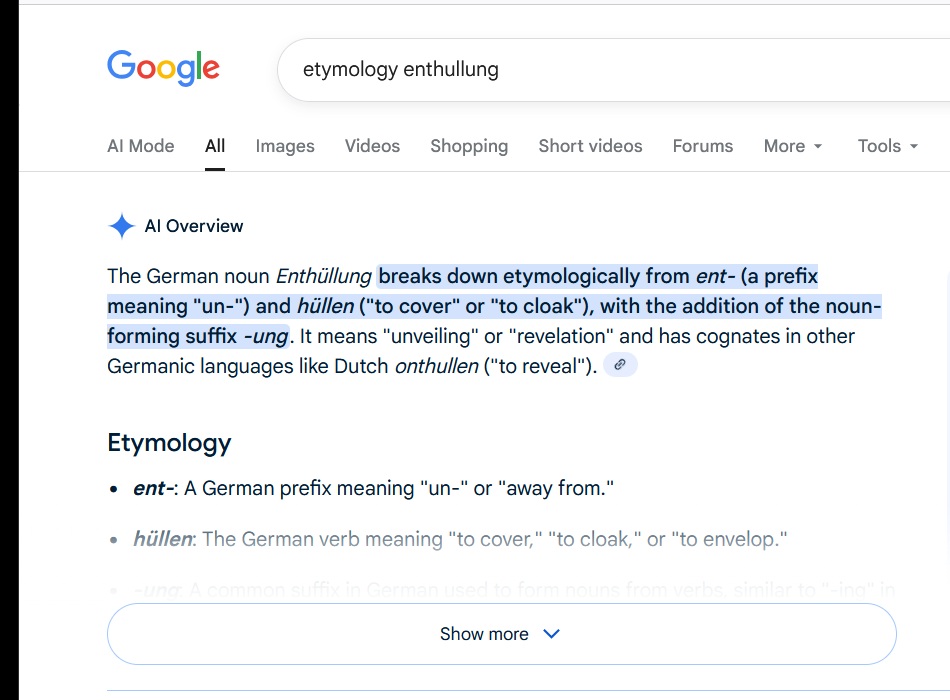

AI Overview: "The word 'hull' comes from Old English hulu meaning 'husk' or 'pod' …."
For the Pod People —
AI Overview: "The city name 'Hull' is a separate origin . . . ."
Vide Ron Shaw of Hull.
March 9, 2025, in this journal . . . "Resonance" —
" 'Resonance' represents an intricate and multi-faceted experience
that pushes the boundaries of conventional art and collaboration.
Conceived by the visionary studio of Gregory and Judith Beylerian
in collaboration with the acclaimed multimedia artist Marcela Nowak,
this exceptional event brought together diverse attendees to engage in
a fully immersive experience aimed at creating resonance amongst the
participants."
— https://www.issuewire.com/a-multi-dimensional-journey-resonance-art-
event-unveils-an-immersive-fusion-of-art-human-connection-and-metaverse-
1777395622653633 … September 18, 2023.
"When all the archetypes burst out shamelessly, we plumb the depths
of Homeric profundity. Two cliches make us laugh but a hundred cliches
move us because we sense dimly that the cliches are talking among themselves,
celebrating a reunion . . . Just as the extreme of pain meets sensual pleasure,
and the extreme of perversion borders on mystical energy, so too the extreme
of banality allows us to catch a glimpse of the Sublime."
— Umberto Eco, “Casablanca: Cult Movies and Intertextual Collage” (1984)
from Travels in Hyperreality.

This journal on the above TikTok posting date —
Some backstory . . .

See as well the previous Log24 post, "A Spell."
"Time casts a spell on you but you won't forget me
I know I could have loved you but you would not let me"
— Stevie Nicks lyrics to an artist's video today.
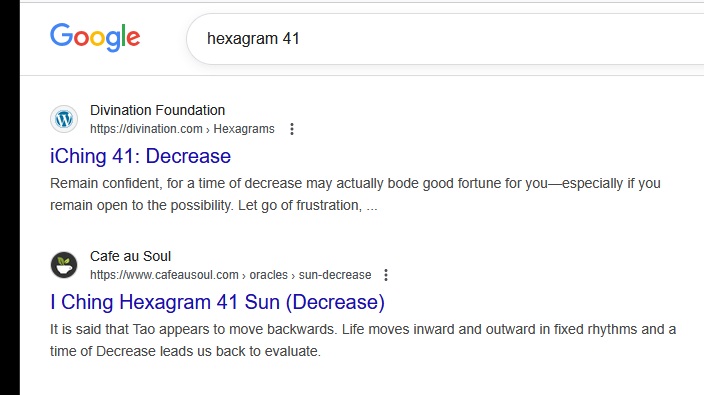
Note the making of a matching pattern.
Click for the most recent related Wikipedia article.
Related meditation . . . The "Back 10" symbol to the left of the donut shop door
above suggests a look at Oct. 16, 2015, in other posts now tagged Backdancing.
For this year's winner of the Nobel prize for literature,
a Hungarian enthusiast of run-on sentences whose "bible"
is said to be the classic novel about Cuernavaca by
Malcolm Lowry Under the Volcano . . .
As season three of "The Diplomat" unfolds, I visit my
memory garden to recall the time I sat with Judge Flick in his
chambers at my hometown courthouse to get a reference for
my application to Harvard and noticed on his desk a copy of
E. B. White's "little book" on prose style which, along with
a library book by Norbert Wiener, may have influenced my
mentioning to the judge the rather strange word "cybernetics,"
derived from the term for the steersman of the ship of Odysseus
who was lost at sea in Homer's epic tale.
"Wiener" of course is another term for a resident of Vienna.
And so, returning to much more recent memories — from
yesterday — of the long strange journey that has been my life . . .
Two references from a much less subjective and much more
objective tale that might amuse the late Hermann Weyl —

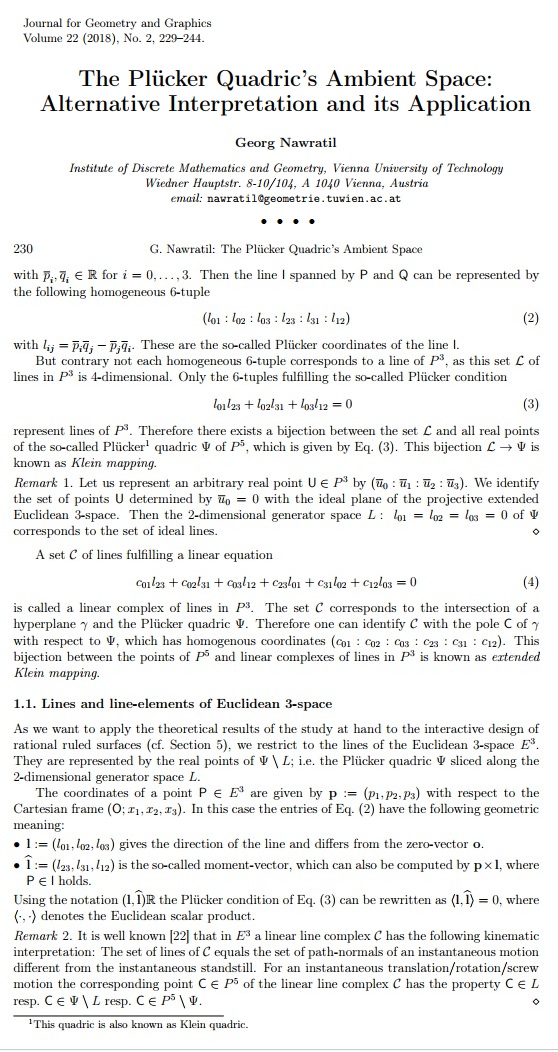
Related picture from a cartoon graveyard —
“Perhaps the philosophically most relevant feature of modern science
is the emergence of abstract symbolic structures as the hard core
of objectivity behind— as Eddington puts it— the colorful tale of
the subjective storyteller mind.”
— Hermann Weyl, Philosophy of Mathematics and
Natural Science , Princeton, 1949, p. 237
Melissa C. Wong, illustration for "Atlas to the Text,"
by Nicholas T. Rinehart:

The above fanciful illustration pictures 6*9=54 colored squares on the six
faces of a 3x3x3 cube.
Compare and contrast the Aitchison labeling, not unlike the one above,
of 6*4=24 unit squares (or, equivalently, 24 pips at the squares' centers)
on a 2x2x2 cube.
Now consider how the 8-square "brick" of R. T. Curtis may be colored with
four colors using the 105 ways to partition its eight squares into four 2-sets.
By analogy, the 24 squares on a cube's surface, as above, afford a cubical
space for applying six colors to the sextet partitions (into six 4-sets) of Curtis's
Miracle Octad Generator (MOG), using Aitchson's cubical model (with, of course,
the parts to be moved being pips or squares rather than cuboctahedron edges).
The 4-coloring of Curtis bricks is useful in picturing the Klein correspondence.
Are there similar uses of cube 6-colorings? Or 4-colorings? (Group actions on
a 6-set are of considerable combinatorial and algebraic interest because of
the exceptional outer automorphism of S6.)
For a colored presentation of sextet space modeled with a rectangle,
as in the Curtis MOG, see . . .

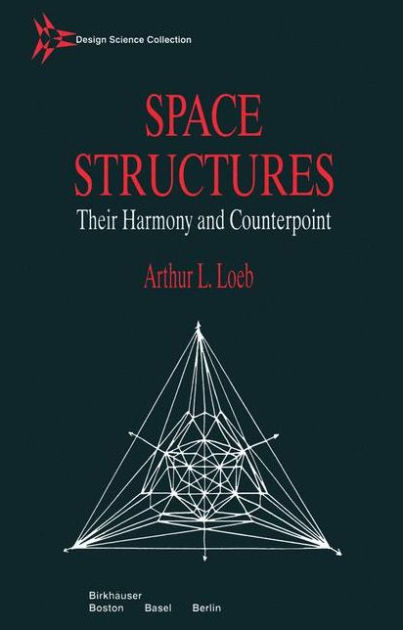
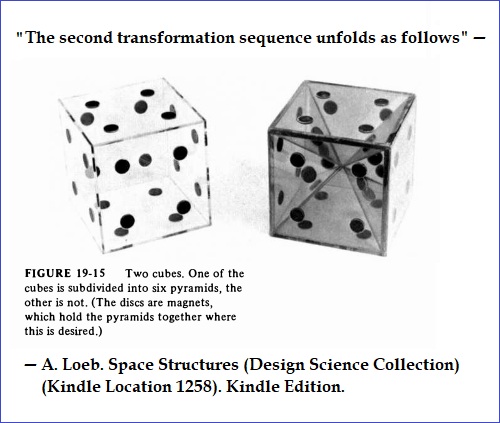
Nabokov's Transparent Things :
"Its ultimate vision was the incandescence of a book or a box
grown completely transparent and hollow. This is, I believe, it :
not the crude anguish of physical death but the incomparable
pangs of the mysterious mental maneuver needed to pass from
one state of being to another. Easy, you know, does it, son."
The great illustrator Drew Struzan reportedly died yesterday at 78.
In memoriam . . .
"After completing the extensive artwork required
for the campaign of Indiana Jones and the Kingdom
of the Crystal Skull, Struzan announced his retirement
on September 3, 2008.[26]
26. "Drew Struzan Retired". TheRaider.net. April 9, 2008.
This journal shortly after the above Sept. 3, 2008, announcement —

Clicking "Explain the ψ mapping" led to Grok attempting to retrieve
a 1992 paper by Baartmans et al. from sciencedirect.com, which has
a captcha to block robot access. This led to . . .

For non-robots, the relevant sciencedirect.com page is . . .
Alphonse Baartmans, Walter Wallis, Joseph Yucas,
A geometric construction of the Steiner system S(4, 7, 23),
Discrete Mathematics, Volume 102, Issue 2, 1992, Pages 177-186,
ISSN 0012-365X,
https://doi.org/10.1016/0012-365X(92)90052-H.
(https://www.sciencedirect.com/science/article/pii/0012365X9290052H)
Abstract: The Steiner system S(4, 7, 23) is constructed from the geometry of PG(3, 2).
Some background from Google's AI Overview —
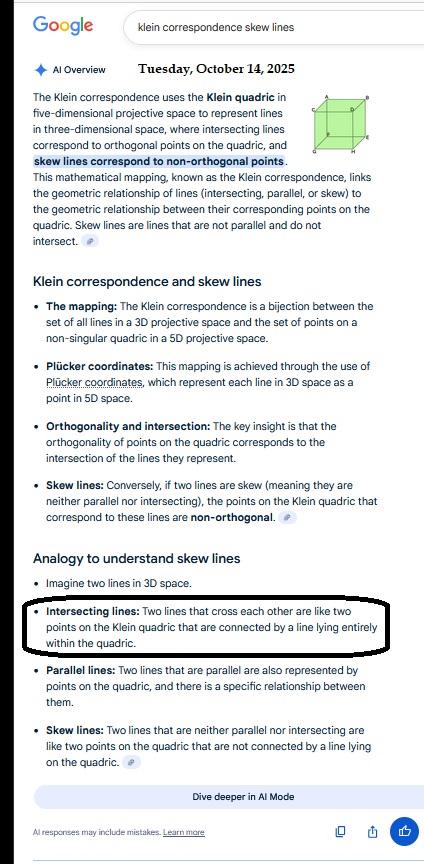
My own illustration of "a line lying entirely within the quadric" —
The University of Ghent animation in the previous post suggests
a check of the author's other pages. One such offering:
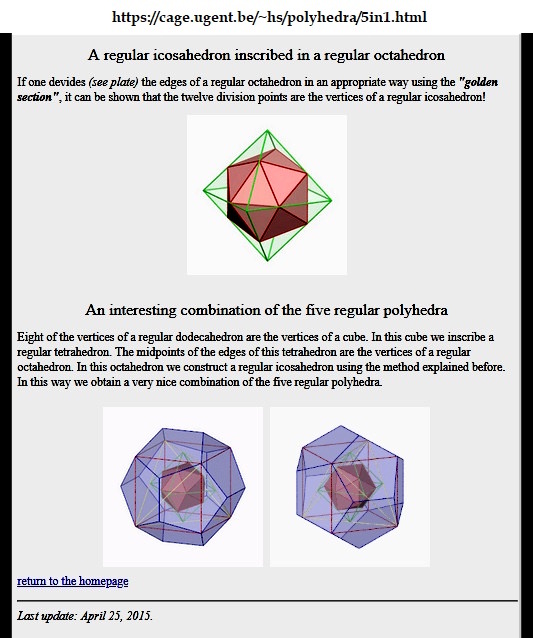
For the Church of Synchronology (and Halloween season) —
One of the April 25, 2015, posts now tagged Contra Faustus:
Also on January 16, 2016 —
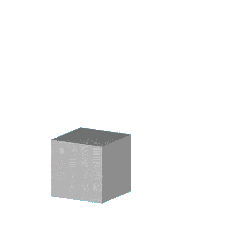
Source of animated gif: https://cage.ugent.be/~hs/polyhedra/dodeca.html.
Related reading —
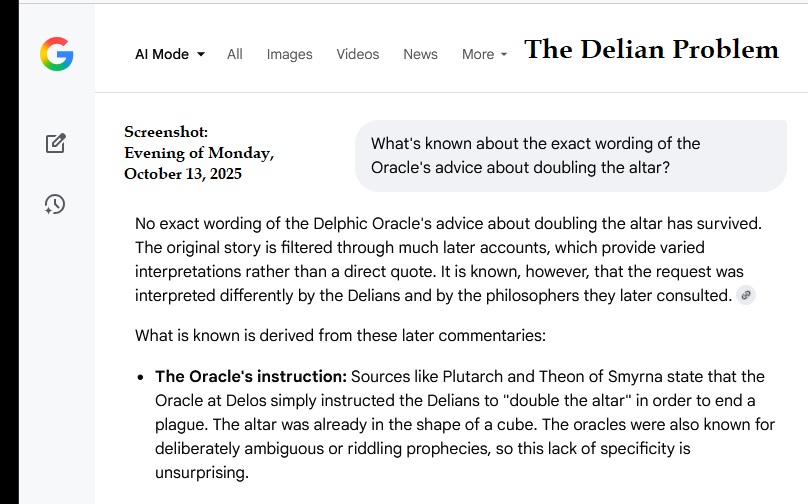
Unfortunately, the volume of the dodecahedron formed by
unfolding a cube as in the University of Ghent animation above
is not double that of the cube, since refolding the cube leaves
an empty space inside … not shown in the Ghent animation.
But taking six congruent square pyramids that form a cube and using
them to cover the faces of a second, congruent, cube yields a
rhombic dodecahedron. This does offer a sort of solution to the
Delian problem… provided the new rhombic-dodecahedral altar is
found to be fit for ceremonial use. See . . .
The New York Times reports today that Searle died on September 16, 2025.
See posts now tagged The Bracketing.
Claude in "Notorious" (1946) —
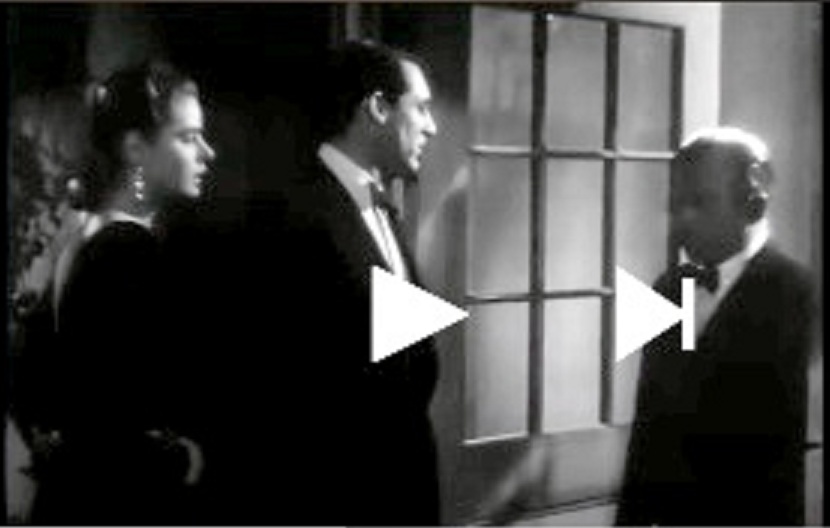
"I'm in with the in grid, I go where the in grid goes."

Midrash for storytellers . . .

This post was suggested by yesterday's update to
the "Analogy Between Analogies" post of October 6.
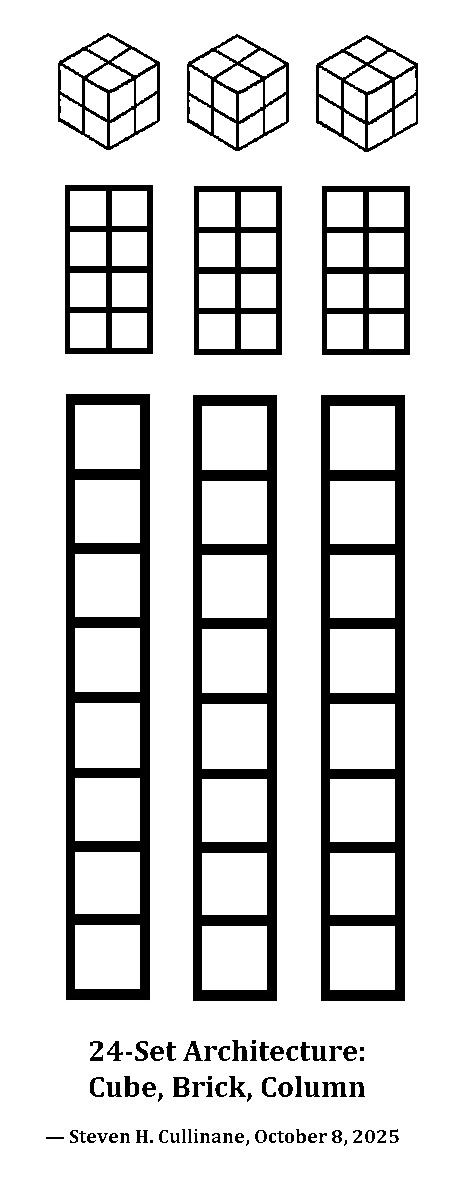
The reason for the above columns . . .
The action of S8 on the rows of an 8-row 3-column matrix
000
001
010
011
100
101
110
111
is intimately connected, via the 30 labelings of a Fano plane
and via the Klein quadric in PG(5, 2), with the action of a
group of order 322,560 on the 16 squares of a 4×4 array.
See Conwell, 1910 [1] and the Log24 tag 105 partitions.
1. Conwell, George M. “The 3-Space PG(3, 2) and Its Group.”
Annals of Mathematics, vol. 11, no. 2, 1910, pp. 60–76.
JSTOR, https://doi.org/10.2307/1967582.
For those who prefer narratives to mathematics: The Cubes.
How best to depict the 30 essentially different such structures is
not clear. See an update to yesterday's post on the structures.
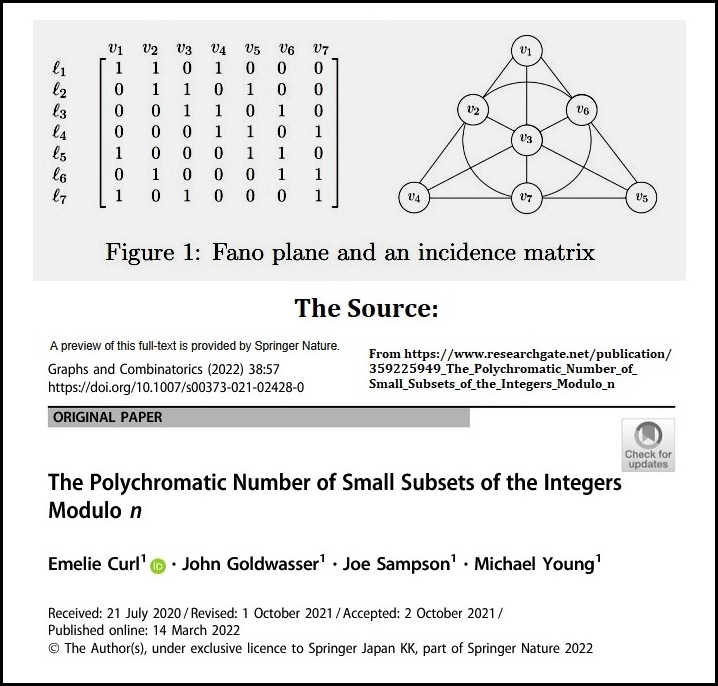
Consider . . .
A. The nontrivial analogy between the two parts of the well-known natural
15+15 partition of the 30 labelings of the Fano plane PG(2, 2)
B. The nontrivial analogy between the two parts of the well-known natural
15+15 partition of the 30 planes of the Klein quadric in PG(5, 2)
Are A and B nontrivially analogous? If so, how?
Update of 6:58 PM EDT Oct. 7 . . .
Hint:
Use as labels for PG(2, 2) points the seven nonzero vectors in the
3-space over GF(2), expressed as 001, 010, 011, 100, 101, 110, 111.
Then form three seven-digit vectors by taking the first, second, and third
digit in each 3-digit vector. View these seven-digit vectors as points of
the Klein quadric in PG(5, 2).
(Distinctness as labelings requires verification.)
Update of 1:35 PM EDT Oct. 7
The above incidence matrices are clearly distinct as matrices, but
whether they show the well-known 30 labelings that are structurally
distinct as labelings is not clear. There seems to be little discussion
of Fano-plane incidence matrices on the Web. One example of such
a matrix with a well-formed structure of cyclically shifted rows —

Related reading for fans of Bradbury's phrase
"patterning windows" and/or Aiken's phrase
"shadow guests" —
The Strong Law of Small Shapes (May 29, 2024).
The Hieronymus Bosch reference in a post yesterday morning
was suggested in part by the surrealistic drama "Changing Stations"
by one Victor Snaith. Snaith reportedly died at 77 on July 3, 2021.
He was a British professor of mathematics. Vide his obituary.
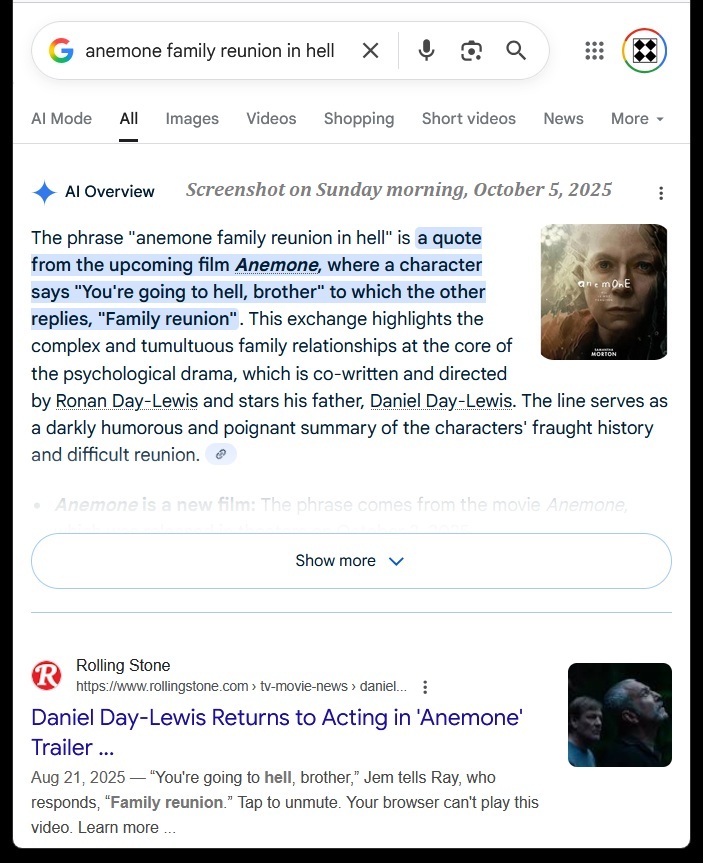
See also this journal on Snaith's reported death date, in other posts
tagged The Holy Field.
Some backstory: Snaith in Log24 posts tagged smallfield.
A mathematician, like a painter or a poet, is a maker of patterns.
If his patterns are more permanent than theirs, it is because
they are made with ideas.
— G. H. Hardy, A Mathematician's Apology (1940).
This post notes three uses of overlapping figures in mathematics.
The idea in each case is that of overlapping.
An old use of overlapping — probably well-known in ancient Greece:
A more recent use of overlapping — Venn diagrams:
My own personal use of overlapping —
half-circle patterns that led to the diamond theorem:
… who reportedly died at 91 on September 24, 2025 . . . .
A synchronology check yields Zadie Smith.
Scholium for St. Bonaventure —

A Log24 search —
http://m759.net/wordpress/?s=Bonaventure —
yields . . .
St. Bonaventure on the
Trinity at math16.com
and
A trinity:
Click on picture for further details.
|
Finite Geometry: A Unifying Framework "In essence, finite geometry, exemplified by the Cullinane diamond theorem, acts as a 'portal' that unveils profound mathematical structures underlying seemingly simple patterns, demonstrating the interconnectedness of geometry, algebra, combinatorics, and visual art, with significant implications for fields ranging from error-correcting codes to experimental design and signal processing." — NotebookLM AI on 18 September 2025 |

See as well a dies natalis on 18 September 2025 —
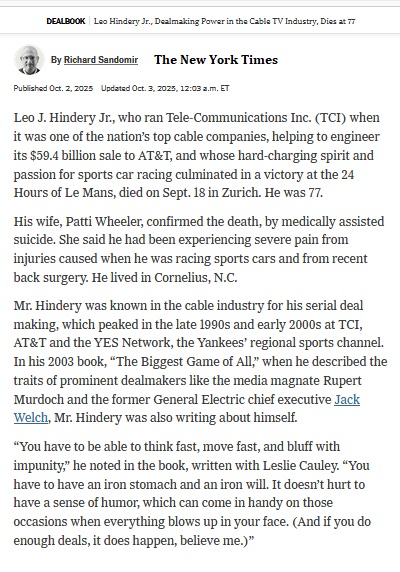
Posts now tagged Incipient Colorings.
Some related mathematics:
From this morning's Log24 post "The Black Van" —


Related reading:
http://m759.net/wordpress/?tag=the-jewels-of-life-and-death.
Related material suggested by news from later today . . .
The above-mentioned news . . .
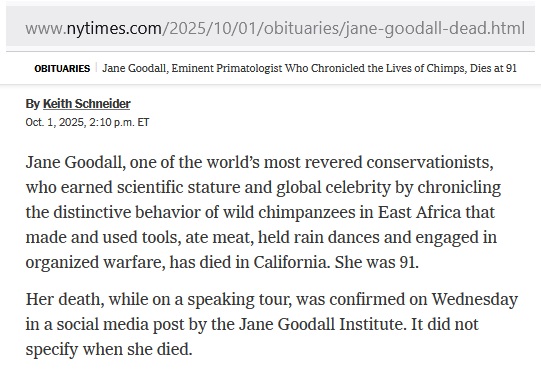
"Holding onto the last of the summer fruit
on the last day of September…" — Lilyjcollins
This post was suggested by the arXiv date of a paper by
Peter J. Cameron on "asymmetric Latin squares" —
8 July 2015 — and by that date in this journal.
250928-Honey_Don't-driving-scene-at-about-0.24.52-
with-1.04.34-remaining-paused-at-about-6.30-AM-EDT
-250928.jpg
* Vide August 19, 2023.
Update, 10:15 AM Sept. 29 —
Another sort of Commedia mythspace:
today's update to the previous post.
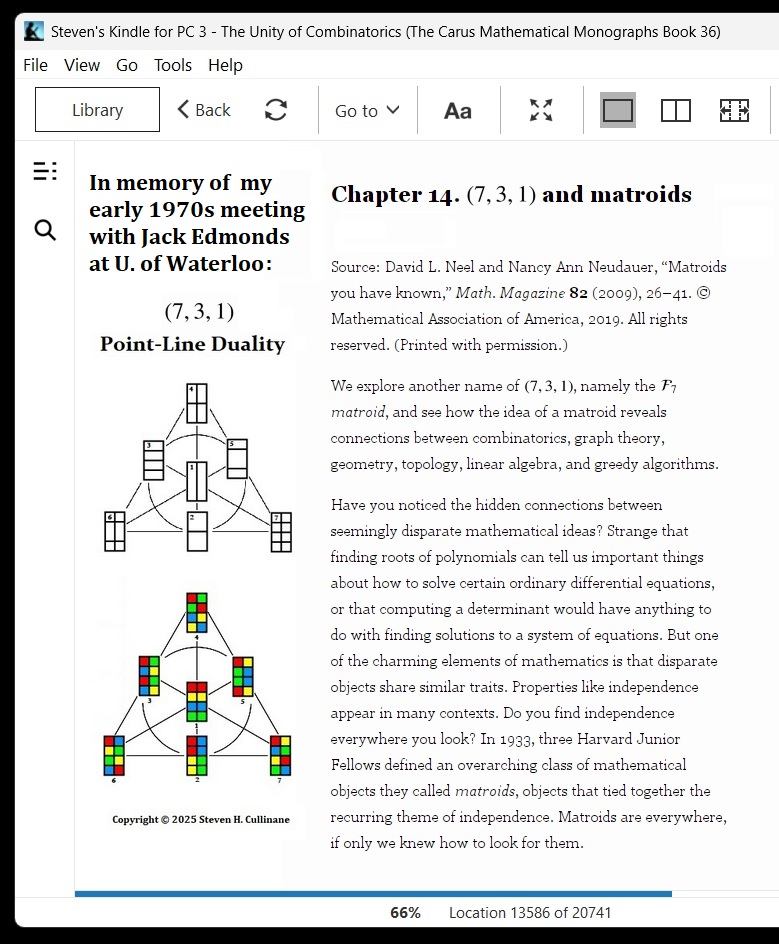
Update on Monday morning, Sept. 29, 2025 —
Related reading . . . Jack Edmonds in Wikipedia and . . .
Edmonds, Jack (1991), "A Glimpse of Heaven,"
in J.K. Lenstra; A.H.G. Rinnooy Kan; A. Schrijver (eds.),
History of Mathematical Programming – A Collection of
Personal Reminiscences, CWI, Amsterdam and North-Holland,
Amsterdam, pp. 32–54
The reported June 21, 2016, dies natalis of Ron Shaw
suggests a flashback . . .
http://m759.net/wordpress/?s="Ron+Shaw" —
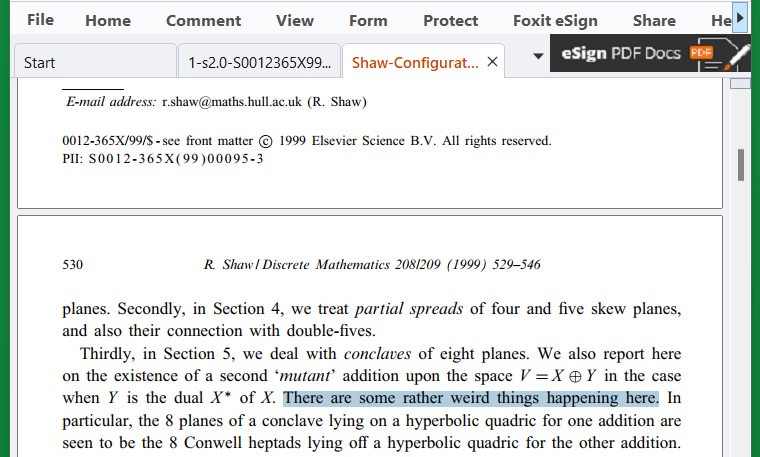
The Klein quadric as background for
the Miracle Octad Generator of R. T. Curtis —
Those who find Kubrick's black 2001 monolith too dark
may prefer a more colorful image, taken from yesterday's
post on the Klein correspondence —
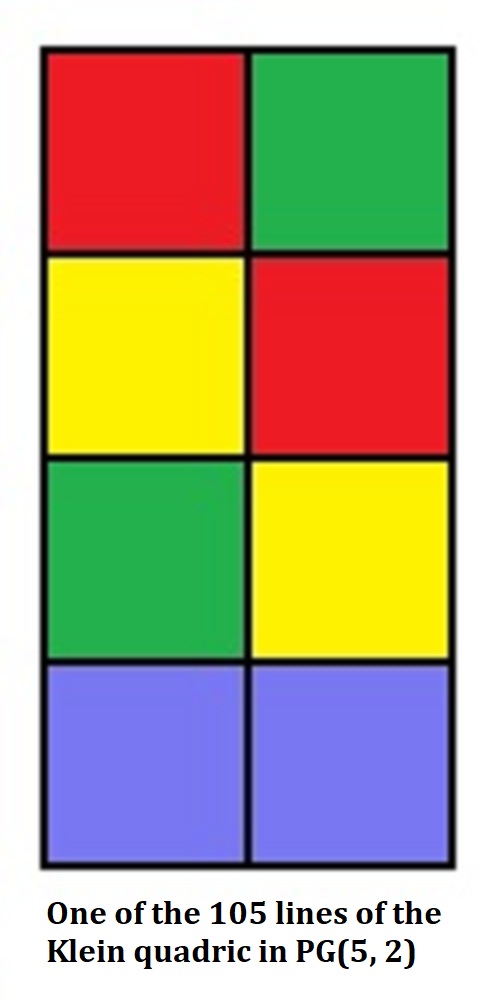
![]()
![]()
And then there is . . . Rube Icon !

This post was suggested by the dies natalis of a figure from
the previous post, one L. S. Dembo.
A New York Times obituary on Sept. 21, 2025 —
"… he was an important, if not famous, figure . . . ."
Likewise . . . the figure 25/24, which in decimal form is
1.041666 . . .
"… the form, the pattern . . . ." — T. S. Eliot
The above fraction, or ratio, is a rational number. There are other
numbers that are not rational . . .
Other posts now tagged Mystery of O … and …

Cover design by Greg Stadnyk, available in an animated gif.

Illustration using Cullinane's four-color decomposition theorem —
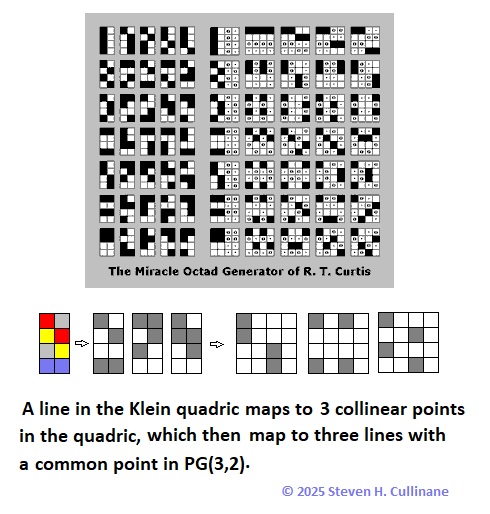
" … fare forward, voyager . . . ." — T. S. Eliot
"In my experience, every kind of writing requires
some kind of self-soothing Jedi mind trick, and,
when it comes to essay composition,
this rectangle is mine."
— Zadie Smith in The New Yorker, Sept. 22, 2025.
A mind trick that is perhaps less self-soothing —
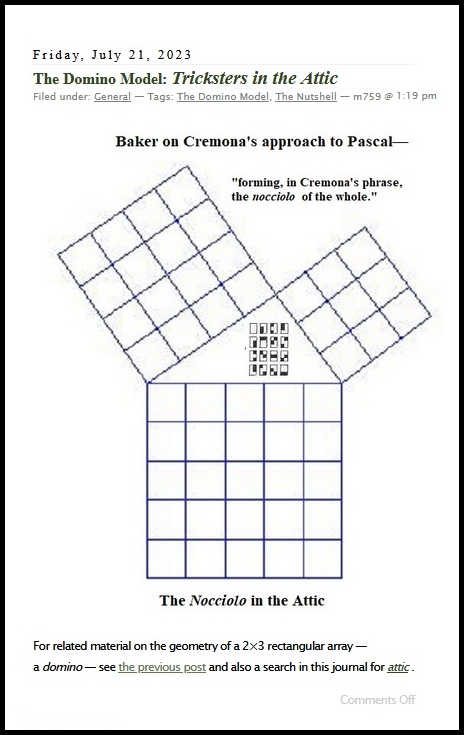
The dimensional reduction above, from six affine dimensions over
GF(2) to four dimensions, is, like a similar reduction in the previous post,
done by considering only even-sized subsets, then considering as elements
only the boundaries between these subsets and their complements . . .
and the Galois (XOR) sums of those boundaties.
http://m759.net/wordpress/?s="six+dimensions+into+three"
The above link is for fans of Richard J. Trudeau's "Story Theory of Truth."
And then from pure mathematics, there is the reduction from eight dimensions
into six of Diamond Theory, in passing from the eight-dimensional affine space
over the two-element Galois field to the six-dimensional affine space used in
Diamond Theory to represent the five-dimensional projective space PG(5,2).
See other posts tagged Klein Space.
From a Log24 post of Oct. 22, 2015 —
Software writer Richard P. Gabriel describes some work of design
philosopher Christopher Alexander in the 1960s at Harvard:

The above 35 strips are, it turns out, isomorphic to
the 35 points of of the Klein quadric over GF(2).
Dialogue from the 2025 film "Fountain of Youth" —
EXTERIOR
– Mum!
– What?
– It's not maths. The pattern they found. It's not maths.
INTERIOR
– It's no good, Luke. The code's a brick wall.
– Then we've gone wrong somewhere. We're missing something.
– Hey.
– Hello.
– No. I don't wanna hear it.
– Sorry.
– Thomas.
– These seven digits aren't numbers. They're musical notes.
– What?
– Most universal language there is.


* See April 23, 2011.
Dialogue in Blade Runner: Black Lotus —
"Do you know who you're starting to sound like?"
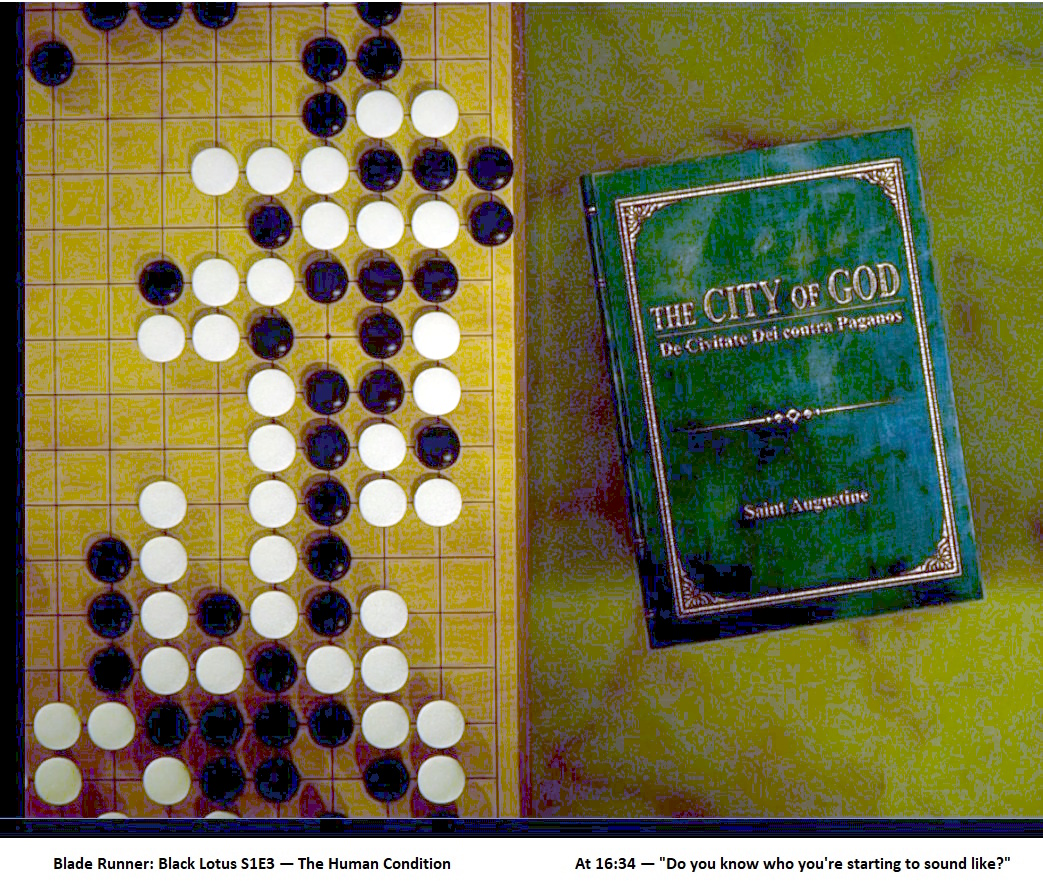
“… Which makes it a gilt-edged priority that one of us
gets into that Krell lab and takes that brain boost.”
— American adaptation of Shakespeare’s Tempest , 1956
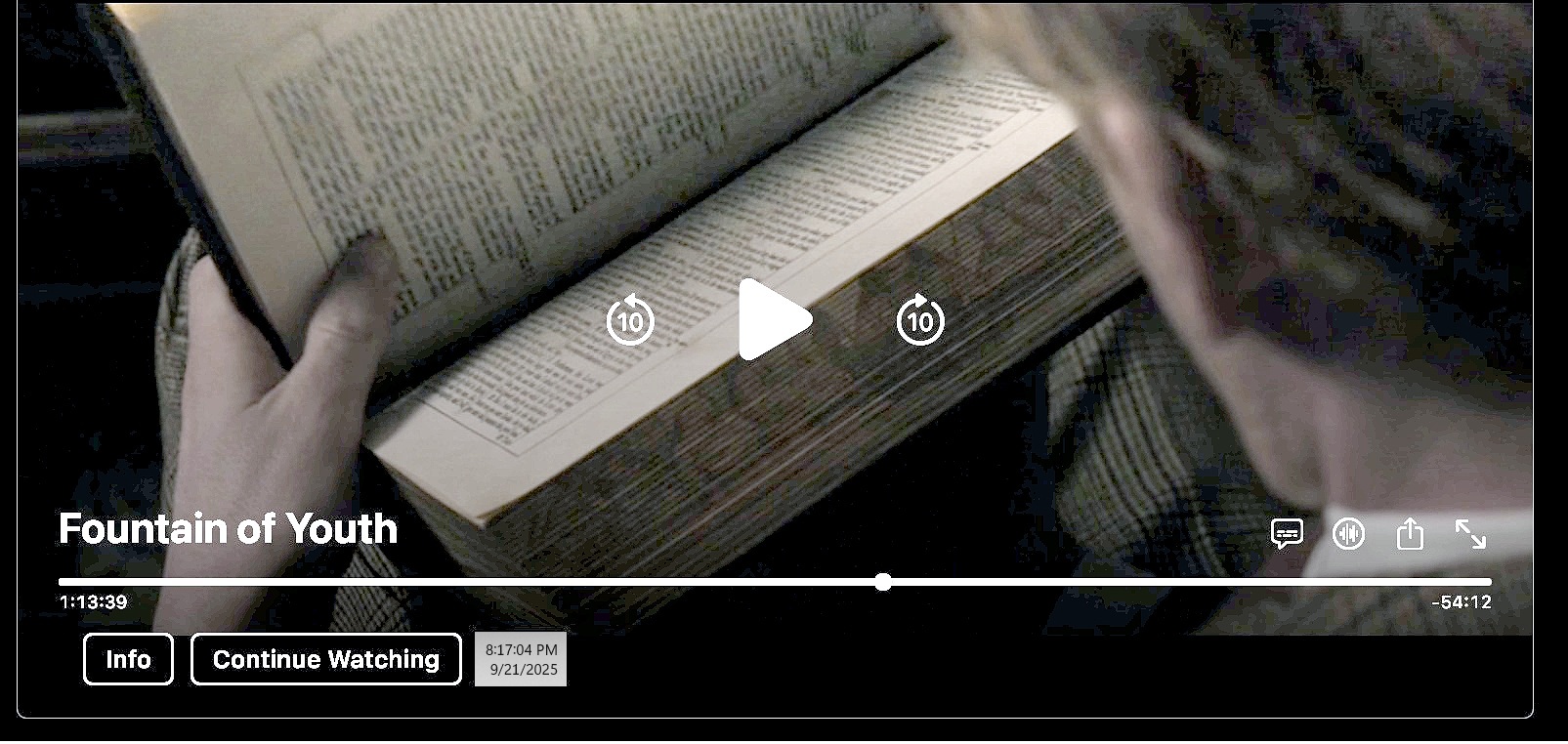
* Noun form of a Heinlein verb.
From a post of April 25, 2025 —

Zip! I was reading Schopenhauer last night.
Zip! And I think that Schopenhauer was right.
— "Pal Joey," 1940 musical by Rodgers and Hart
From a 2025 Apple TV+ film written by
James Vanderbilt —

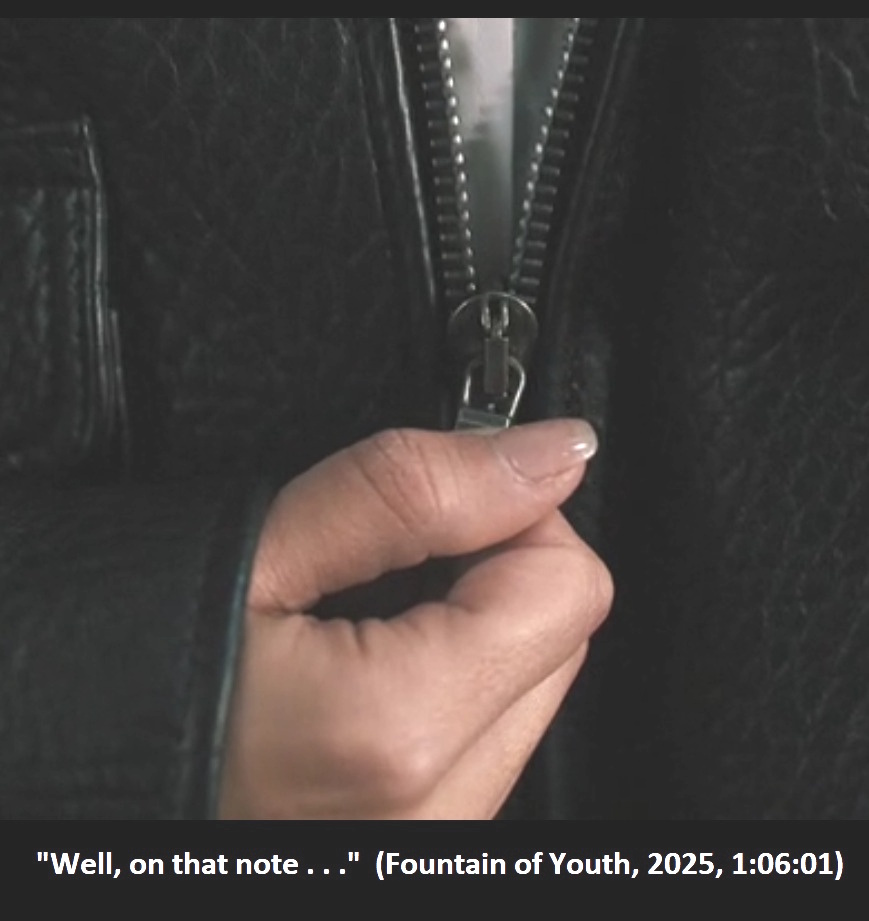
http://m759.net/wordpress/?s=Matrix+Design
http://m759.net/wordpress/?s=Matrix+Resurrections
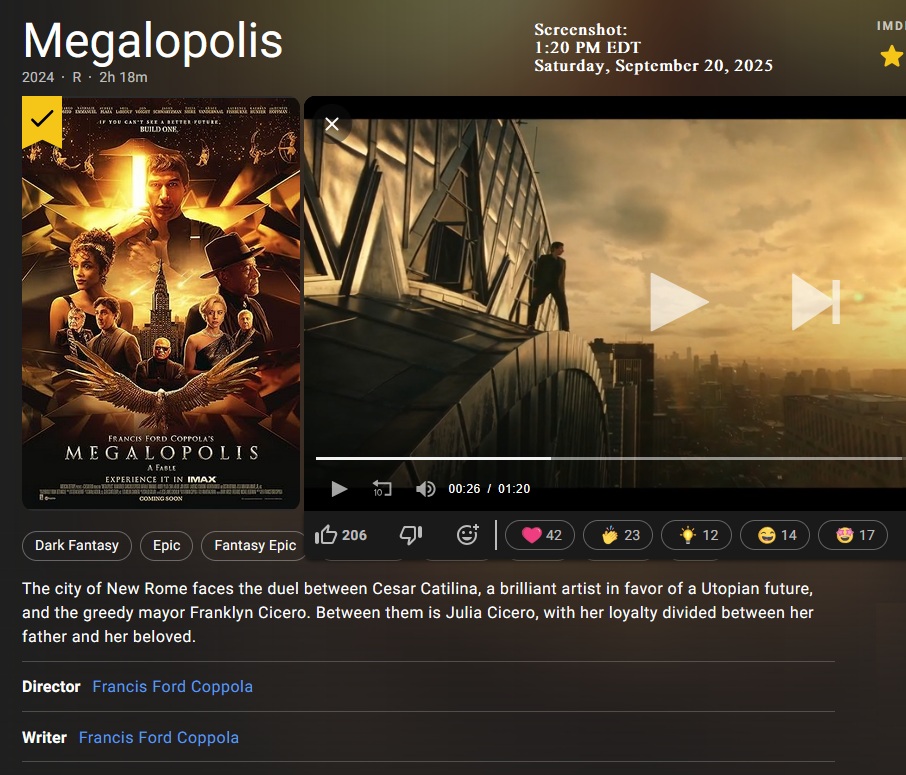
"Been there, done that." — John Wick
* See as well the above Klein date —
Dec. 19, 2021 — in this journal.
The relevant name here is not that of Jonathan Miller . . .
From the artificial intelligence at NotebookLM on Sept. 18, 2025 —
"Bridging Visual Art and Combinatorics
with Finite Projective Geometry
The Cullinane diamond theorem is a prime example,
originating from observations of symmetries in
traditional quilt designs and graphic art."
This is false.
The patterns in the diamond theorem originated from observing
superimposed 4×4 arrays of half-circles.
Vide http://finitegeometry.org/sc/16/overlay.html.
"Principal photography began on September 24, 2018, in Boston…."
— Wikipedia on the 2020 film Ava .
Also on September 24, 2018 —
Among possible meanings of beauty —
http://m759.net/wordpress/?s="Gideon+Summerfield"
"This mathematical framework links seemingly simple designs,
like quilt patterns, to complex concepts such as the Mathieu group M24,
the Miracle Octad Generator (MOG), and error-correcting codes."
Art from 1976 —
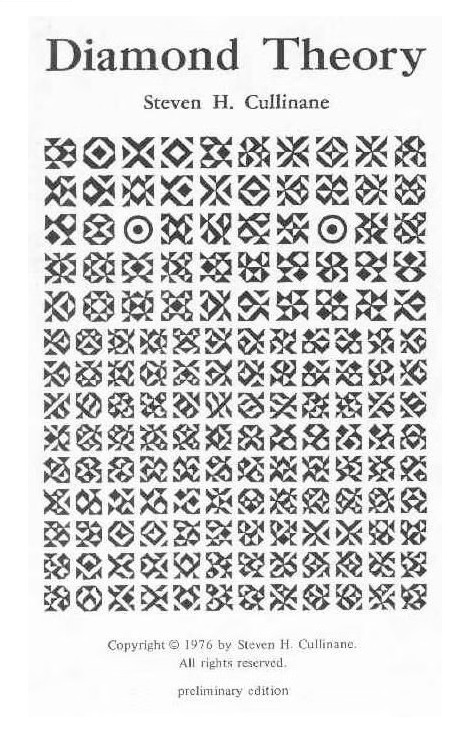
Art from 2025 —
A mathematician, like a painter or a poet, is a maker of patterns.
If his patterns are more permanent than theirs, it is because
they are made with ideas.
— G. H. Hardy, A Mathematician's Apology (1940).
In other art news . . .
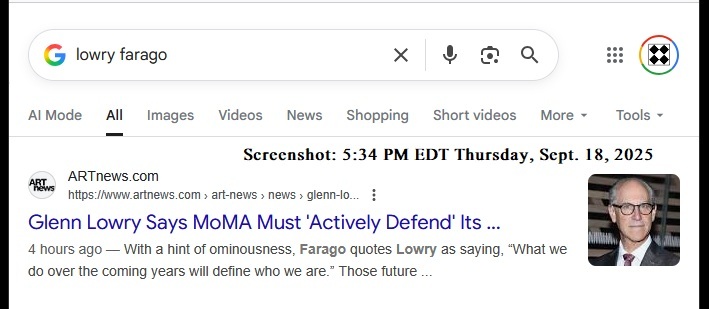
Images from https://shc7596.wixsite.com/website —

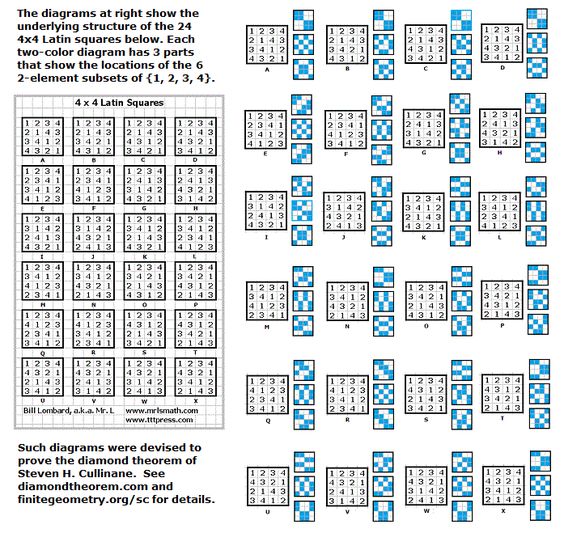
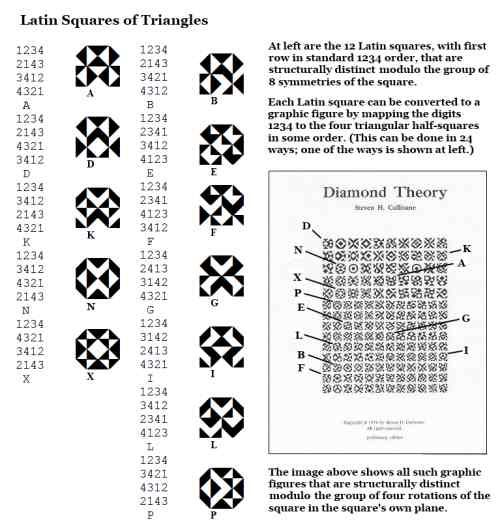
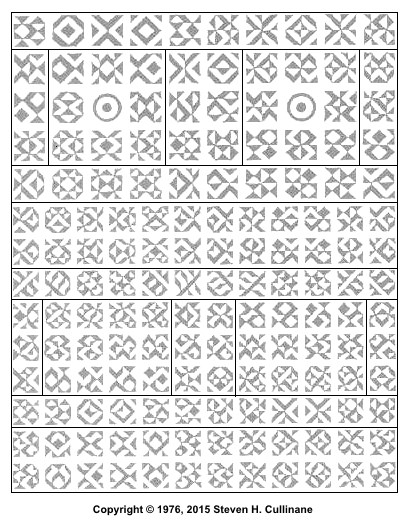
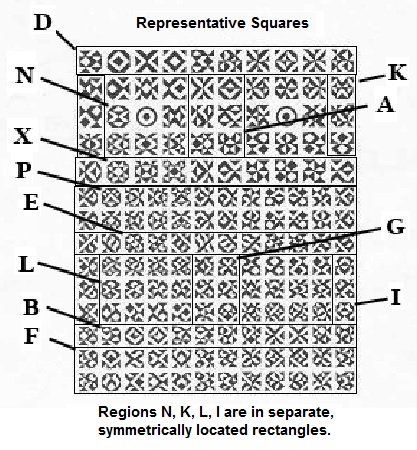
This post has been uploaded as a PDF to the NotebookLM
public notebook at https://notebooklm.google.com/notebook/
62ad8daa-277e-4fea-a680-9b209883f232.
A copy of the PDF is at
http://log24.com/log25/250918-Contrapuntal_Structure_
in_Latin_Squares-from-Log24.pdf.
|
Finite Geometry: A Unifying Framework by NotebookLM on September 18, 2025 Finite geometry serves as a powerful unifying framework that bridges diverse mathematical disciplines with artistic and practical applications, primarily by revealing deep underlying symmetries and structures. Here's how finite geometry achieves this unification:
In essence, finite geometry, exemplified by the Cullinane diamond theorem, acts as a "portal" that unveils profound mathematical structures underlying seemingly simple patterns, demonstrating the interconnectedness of geometry, algebra, combinatorics, and visual art, with significant implications for fields ranging from error-correcting codes to experimental design and signal processing. * This AI statement is false. See "Origin," Sept. 20, 2025. |
For those who prefer narratives to mathematics . . .
Abacus Conundrums (Monday, Sept. 15, 2025).
The number of subsquares in each large square
below is a prime power. Therefore each large square
is a Galois space.
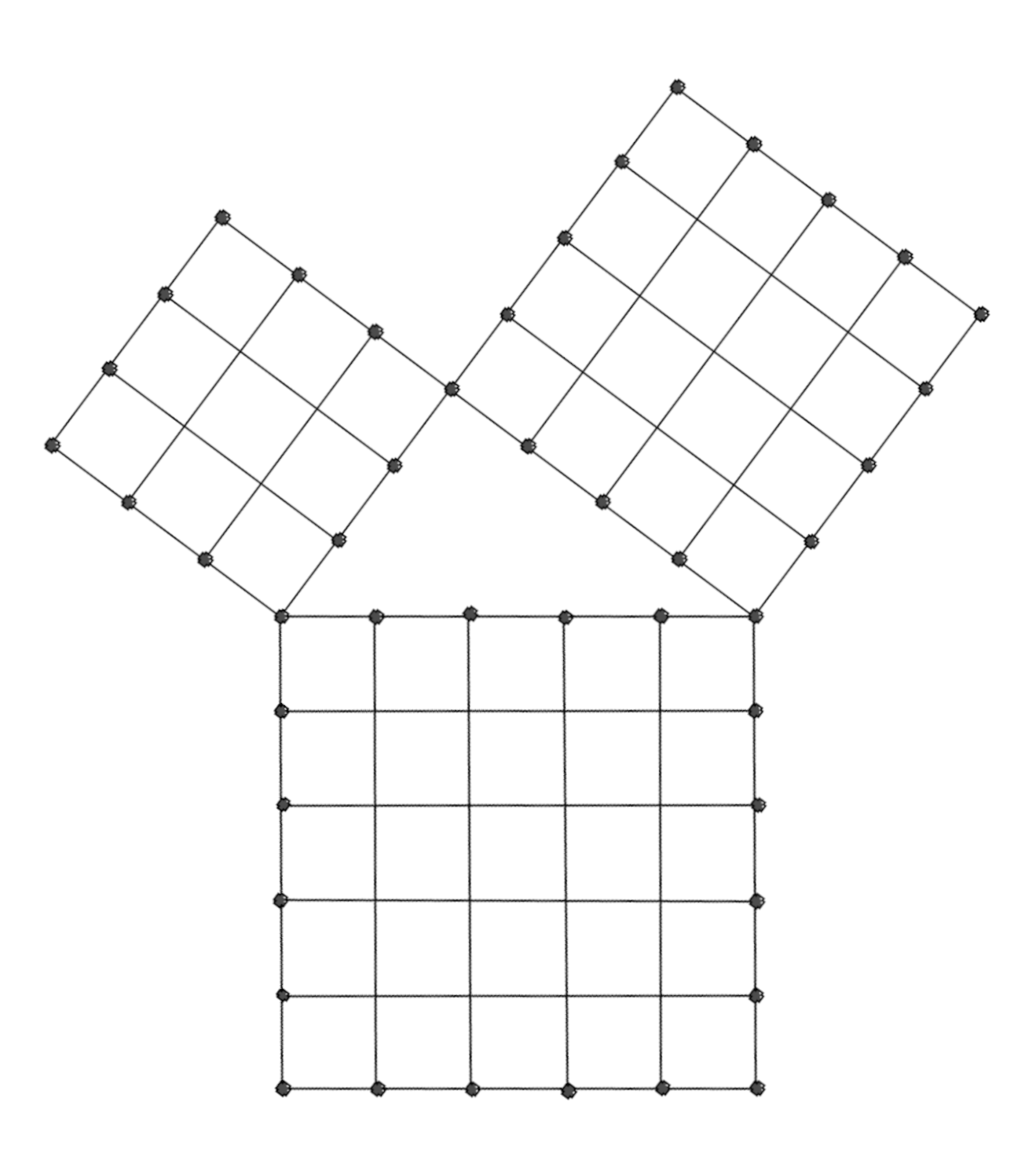
Related material at NotebookLM —
https://notebooklm.google.com/notebook/
62ad8daa-277e-4fea-a680-9b209883f232
and a copy at Log24.com —
http://log24.com/log25/
250917-'Diamond_Theory-NotebookLM'-notebooklm.google.com.pdf

* Vide a Log24 search for "Twin Pillars."
. . . and for Harlan Kane
|
From “Mimsy Were the Borogoves” (Padgett, 1943) —
…”Paradine looked up. He frowned, staring. What in— |
|
From City of Illusions (Le Guin, 1967) — All the top of the table, Falk now saw, was sunk several inches into a frame, and contained a network of gold and silver wires upon which beads were strung, so pierced that they could slip from wire to wire and, at certain points, from level to level. There were hundreds of beads, from the size of a baby’s fist to the size of an apple seed, made of clay and rock and wood and metal and bone and plastic and glass and amethyst, agate, topaz, turquoise, opal, amber, beryl, crystal, garnet, emerald, diamond. It was a patterning-frame, such as Zove and Buckeye and others of the House possessed. Thought to have come originally from the great culture of Davenant, though it was now very ancient on Earth, the thing was a fortune-teller, a computer, an implement of mystical discipline, a toy. In Falk’s short second life he had not had time to learn much about patterning-frames. Buckeye had once remarked that it took forty or fifty years to get handy with one; and hers, handed down from old in her family, had been only ten inches square, with twenty or thirty beads… . . . . A crystal prism struck an iron sphere with a clear, tiny clink. Turquoise shot to the left and a double link of polished bone set with garnets looped off to the right and down, while a fire-opal blazed for a moment in the dead center of the frame. Black, lean, strong hands flashed over the wires, playing with the jewels of life and death. “So,” said the Prince, “you want to go home. But look! Can you read the frame? Vastness. Ebony and diamond and crystal, all the jewels of fire: and the Opal-stone among them, going on, going out. |


Powered by WordPress